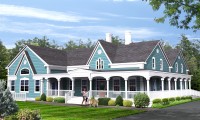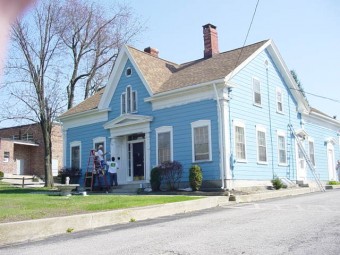A Veterinary Clinic Blends State-of-the-art Technology with Traditional Values
Technology in many ways has made our lives simpler and faster. As in all industries, medicine has become very high-tech in recent years, helping doctors to perform thorough, less-invasive examinations to hasten diagnoses. However, patients sometimes feel like faceless numbers in a doctor’s fast-paced day—nothing like the days of country doctors who took the time to have conversations with their patients to really understand their ailments, increasing patients’ comfort levels and often leading to better diagnoses and treatments.

Drs. Mark and Danielle Paradise, owners of NorthPaws Veterinary Center, Greenville, R.I., believe in “modern medicine, traditional values,” making those words the tagline of their veterinary practice. The building they practice in—a retrofitted 150-year-old Victorian home—is the physical embodiment of their philosophy. Mark Paradise, VMD, explains: “My wife and I offer high-level, technologically advanced care: We have digital x-rays, ultrasounds, in-house blood work and electronic medical records. But we wanted to start a practice that had that old, country-doctor feel. We take the time to learn what’s best for clients and their pets based on the circumstances. We try to balance the high tech with a homey feel.”
Helping to create that balance was Ed Lyons, president of Falcon Associates Architects Inc., Sharon, Mass. Lyons has made animal hospitals a niche of his 35-year-old fi rm but had never designed one like NorthPaws Veterinary Center. “I’ve always been very contemporary,” he says. “But you couldn’t renovate this building and not pay attention to what it was.”
The Paradises fortunately had strong ideas about what they wanted, helping Lyons to honor the Victorian home while turning it into a state-of-the-art vet clinic.
Homework
The Paradises were working at other veterinary practices in Rhode Island in the early 2000s but always planned to have their own. They searched for established practices to buy and began working on a business plan. With help from the Rhode Island Economic Development Corporation, Mark honed in on the village of Greenville, which has more than 8,600 people.
Each day, the Paradises drove past a charming, blue Victorian home located on a busy Greenville corner. Mark mentioned to Danielle that the house, which already was used by a commercial business, would make a good spot for a practice. In mid-2003 the house became available, and Mark and Danielle leased it with an option to buy. The couple and their staff did some preliminary renovations simply to operate in what then was a 2,300-square-foot home.

Two years after leasing the home, the Paradises were faced with the decision to buy. “I hired an architect to give me a footprint of what an expansion would look like on the property,” Mark explains. “A lawyer and I took that footprint to the zoning board to get an approval for an expansion that I wasn’t planning on doing for another couple years, but I wasn’t going to buy the building if they weren’t going to let me expand. When I got the OK for the expansion, we purchased the property.”
Mark again did his homework when searching for an architect who could help him and his wife expand the clinic in a thoughtful way. During their first two years in business, the Paradises banded with the community to thwart a road expansion by the Department of Transportation that would’ve demolished the clinic and three houses behind it. “The obligation to the community after having saved the property from eminent domain put a little twist on things because we couldn’t go changing the house dramatically,” Mark notes. “It also was important for me to keep the philosophy we had already established—high-tech service in a homey environment.”
Years before, Mark had visited an animal hospital whose design he particularly liked and coincidentally his current bookkeeper had once worked there. She shared Ed Lyons’ name as the hospital’s architect. After contacting Lyons, the Paradises visited several more of his animal hospital projects and liked what they saw. Mark explains: “One of the strongest points we took away from the owners of the clinics we visited was that Lyons understands veterinary medicine well enough, but he also is very open to listening to what we wanted and helping us build what we wanted to build.”
Lyons adds each of the animal hospitals he has designed has been unique. “Every vet has a different approach to things, and I pride myself on being a good listener,” he says. “A driving force of any animal-hospital design is people have to bring their pet to the vet and you don’t want to make it a problem for the clients or pets. Mark took this idea one step further by actually practicing in a home, which I think is very nice.”

